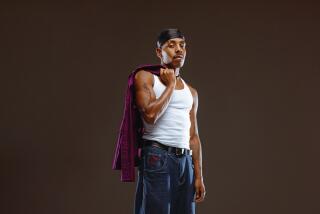Eurythmeum Stuttgart: Vocabulary of Dance
Imagine a stage awash with performers shrouded in yards of colorful, diaphanous fabric. They move in stately, fluid patterns under ever-changing colored lights to live music or to the rise and fall of the spoken voice. The spectacle combines something of the sensuousness of a ‘60s light show with the spiritualistic aura of early 20th-Century modern dance.
This is eurythmy, a form of movement envisioned by its creator, Rudolph Steiner, as “a continuation of divine movement” in which speech and music are “made visible.”
Last seen in Los Angeles in 1981, Eurythmeum Stuttgart--the West German company Steiner founded in 1924--is at the Wadsworth Theatre tonight on the first stop of a three-city U.S. tour.
Else Klink, 82, is the troupe’s artistic director and choreographer. Born in New Guinea to a Polynesian mother, Klink was 7 when her German father deposited her in the Waldorf School that Steiner founded in Stuttgart (the first of what was to become a worldwide network of private schools dedicated to his teachings).
A couple of years earlier, the Austrian-born philosopher had developed eurythmy--with actress Marie von Sivers--and founded the Anthroposophical Society, a group dedicated to the belief that the human intellect can make contact with the spiritual world.
“Children loved Steiner,” Klink said last week from a small town in southern Australia where the company was on tour. “If he (observed) classes, we felt free, with no pressure. He was not like a guru!”
Although a foot injury a few years later put an end to her hopes of becoming a ballet dancer, Klink was an eager student of eurythmy, part of the Waldorf School curriculum. She eventually joined the stage troupe at the Goetheanum in Dornach, Switzerland, the “school of spiritual science” Steiner founded in 1913, and became co-director of Eurythmeum Stuttgart in 1935.
Among the works that the 16-member touring section of the troupe will interpret locally are an excerpt from Klink’s “Peer Gynt” (based on Henrik Ibsen’s verse-drama, with incidental music by Edvard Grieg), Shostakovich’s Cello Sonata in D minor, one of Brahms’ Hungarian dances and such musical desserts as Debussy’s “Golliwog’s Cakewalk.”
Klink explained that eurythmy comes from Greek words meaning beauty and harmony. Further clarifications tended to bog down in jargon and linguistic confusion. Hampered by speaking in English, a language not her own, Klink tossed out phrases like “the soul spreads out in movement” and “dance becomes an impulse from soul-wisdom”--and balked at decoding them.
Eurythmists dance as the spirit moves them--the spirit as interpreted by Steiner’s dogma, that is. Believing that every sound in speech is actually an invisible gesture, Steiner proposed that aspects of sound--including pitch, rhythm and dynamics--could be interpreted by specific movements or areas of the body. The sound “oh,” for example, requires the arms to embrace space; the collarbone is the unlikely spot at which a performer supposedly experiences a tonic chord.
At times, however, performers break away from interpreting the separate sounds of the text or music to reveal what eurythmists call its “mood of the soul”--such states of mind as grief, merriment or reverence.
“If you speak and move,” Klink said in her slow, measured voice, “in these movements (are embodied) thought, feeling and will.” Depending on its emphasis and rhythm, a gesture moving outward from the body may convey sympathetic feelings or willfulness; inward-turning gestures may reflect the state of thought or the feeling of distaste.
Performers walk or run on half-toe, using their arms and hands to interpret the specific sound qualities. The gossamer, airborne cloaks the eurythmists wear help focus the audience’s attention on flowing gestures rather than the specific body that creates them.
In addition to the vocabulary of gesture, eurythmy also involves constantly changing lighting patterns that portray, Klink says, “the color of the mood of soul,” as reflected in the particular passage of text or music. A red light denotes anger; sadness is conveyed with green and blue.
Absorbing the complex rules of eurythmy involves a four-year basic training, with three to five years more study for those who want to pursue stage careers. (Others choose to teach or to become movement therapists for the mentally ill.) But the payoff is that a performer can continue almost indefinitely.
“It’s not an art form which stretches the body to its utmost extent,” said Klink--who still performs short pieces on occasion. “It mobilizes very different forces in you.”
More to Read
The biggest entertainment stories
Get our big stories about Hollywood, film, television, music, arts, culture and more right in your inbox as soon as they publish.
You may occasionally receive promotional content from the Los Angeles Times.










